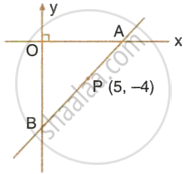Advertisements
Advertisements
Question
Show that the line segment joining the points (–5, 8) and (10, −4) is trisected by the co-ordinate axes.
Solution

Let the points A (–5, 8) and B (10, −4).
Let P and Q be the two points on the axis which trisect the line joining the points A and B.
∵ AP = PQ = QB
∴ AP : PB = 1 : 2 and AQ : QB = 2 : 1

Now, co-ordinates of P will be,
`x = (1 xx 10 + 2 xx (-5))/(1 + 2)`
= `(10 - 10)/3`
= 0
y = `(1 xx (-4) + 2 xx 8)/(1 + 2)`
= `(-4 + 16)/3`
= `12/3`
= 4
∴ Co-ordinates of P are (0, 4)

Co-ordinates of Q will be,
`x = (2 xx 10 + 1 xx (-5))/(2 + 1)`
= `(20 - 5)/3`
= `15/3`
= 5
`y = (2 xx (-4) + 1 xx 8)/(2 + 1)`
= `(-8 + 8)/3`
= `0/3`
= 0
∴ Co-ordinates of Q are (5, 0)
Hence Proved.
APPEARS IN
RELATED QUESTIONS
Prove that the diagonals of a rectangle bisect each other and are equal.
Show that the mid-point of the line segment joining the points (5, 7) and (3, 9) is also the mid-point of the line segment joining the points (8, 6) and (0, 10).
The point P (5, – 4) divides the line segment AB, as shown in the figure, in the ratio 2 : 5. Find the co-ordinates of points A and B. Given AP is smaller than BP.

Find the ratio in which the line x = O divides the join of ( -4, 7) and (3, 0).
Also, find the coordinates of the point of intersection.
The points A, B and C divides the line segment MN in four equal parts. The coordinates of Mand N are (-1, 10) and (7, -2) respectively. Find the coordinates of A, B and C.
Find the ratio in which the line segment joining P ( 4, -6) and Q ( -3, 8) is divided by the line y = 0.
Using section formula, show that the points A(7, −5), B(9, −3) and C(13, 1) are collinear
If point P(1, 1) divide segment joining point A and point B(–1, –1) in the ratio 5 : 2, then the coordinates of A are ______
The points A(x1, y1), B(x2, y2) and C(x3, y3) are the vertices of ∆ABC. The median from A meets BC at D. Find the coordinates of the point D.
Find the coordinates of the point R on the line segment joining the points P(–1, 3) and Q(2, 5) such that PR = `3/5` PQ.
